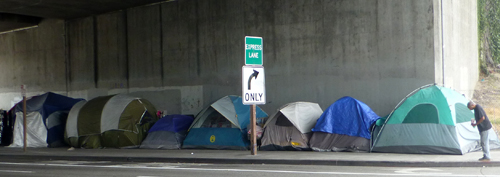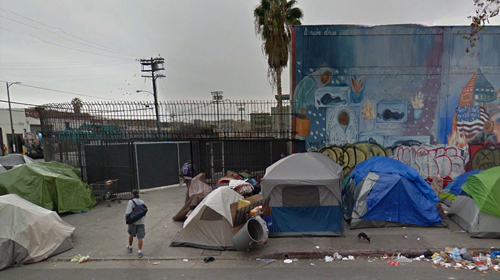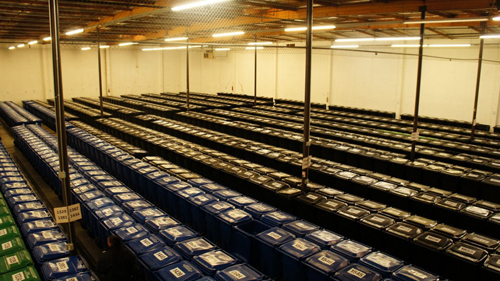Ron Galperin’s Report on Homeless Camps

Leslie Evans
What is L.A. doing with the camps while waiting for housing and shelters to be built?
A read through the 46 dense pages on homeless camps released September 27 by City Controller Ron Galperin reveals a maze of overlapping jurisdictions that have difficulty communicating with each other, laws that are sometimes ambiguous, often not enforced, legal restrictions, and stalled plans to expand storage facilities for homeless belongings, still limited after years of discussion to a single building in Skid Row.
That doesn’t mean that nothing is being done. There is clearly an aggressive effort to clean up street camps. The devil, as usual, is in the details.
What Does the Law Say?
The Los Angeles Municipal Code does not specifically mention homelessness. It restricts itself to saying what people can do, or place, on public sidewalks or in parks. There are two essential ordinances that affect the homeless. LAMC 56.11, Storage of Personal Property, and LAMC 41.18(d), Sidewalks: “No person shall sit, lie or sleep in or upon any street, sidewalk or other public way.”
Currently, LAMC 56.11 allows a person to retain on the street only the amount of property that will fit in a standard Department of Sanitation 60-gallon trash container. If a camp is cleared, an attempt is made to distinguish property from trash, with the trash disposed of, while an unlimited amount of property that is not claimed on the spot is taken to the Bin, 501 Towne Avenue, LA 90013 in Skid Row. Only 3-5% of this confiscated property is ever claimed. It is kept for 90 days and then disposed of.
In 2003 the Ninth Circuit Court ruled LAMC 41.18(d) unconstitutional, as a cruel and unusual punishment for someone who is homeless. In 2007 in an agreement with the ACLU the city established the rule that homeless can sleep on the street between 9:00 pm and 6:00 am, but must dismantle tents and tarps during the day. The Galperin report concedes that “Said ban based on time of day has largely not been enforced.”
There was a sunset clause in the 2007 agreement. People would be allowed to sleep on the streets between 9:00 pm and 6:00 only “until an additional 1250 units of permanent supportive housing are constructed within the City of Los Angeles.” The Galperin report says it thinks it can prove that this total has been reached. But in the meantime, city homeless increased 20 percent since January 2016, and Galperin’s report itself puts the increase at 80 percent since 2009. So, the 1250 units are meaningless for the 25,000 unsheltered still living on the streets. Denying them the right to sleep just goes back to the cruel and unusual punishment disallowed by the Ninth Circuit Court in 2003.
What Agencies Do the Cleanups and Under What Rules?
There are three city programs tasked with cleaning homeless camps.
Operation Healthy Streets (OHS) was established in 2012. It serves only Skid Row and Venice. The lead agency is the Department of Sanitation (LASAN), with security by LAPD. It has large teams that clean Skid Row Monday through Thursday and Venice on Friday. They remove bulky items from camps and illegal dumping. Sidewalks and streets are power washed. Street cleaning in Skid Row is every other week.
Clean Streets LA (CSLA) was added in April 2015. LASAN is also the lead agency. This program goes throughout the city to homeless locations. This is also a large team with multiple vehicles. It includes removing bulky items from camps and illegal dumping. It power washes the location. Security is by LAPD.
Homeless Outreach and Proactive Engagement Teams (HOPE). LAPD is the lead agency. Their mission is limited to ensuring that sidewalks have 3 feet clear to comply with the Americans with Disability Act, that driveways are clear, and camps are 10 feet from doorways. They operate Monday through Thursdays throughout the city. LASAN assists, removing bulky items from camps and illegal dumping, but the HOPE teams do not do power washing.
The Los Angeles Homeless Services Authority (LAHSA) performs outreach for all three of the above programs. Their preapproval is required for the OHS and CSLA cleanups, but not for the HOPE teams. The first two require advance notice, posting the area 24-72 hours in advance. The HOPE teams have a more limited goal and under law are not required to pre-post to provide navigable sidewalks or keep doorways clear.
These programs are limited to operate on city property. There are many homeless who camp within the city, but on Cal Trans property: landscaped margins on the sides of freeways, freeway underpasses, and on- and off-ramps. Also, Recreation and Parks has responsibility for camping in parks, and Metrolink for its trains and stations.
Mental Health and the Street Homeless
While focused mainly on how to deal with current street camps rather than long-range solutions to homelessness, the Galperin report makes an exception for the mentally ill. More than 10,000 of the city’s homeless are mentally ill. These, along with 5,894 disabled homeless, constitute a disproportionate share of the denizens of street camps. The report notes that the closure of compulsory inpatient mental institutions by Governor Reagan in 1967 cut the number of inpatients from 560,000 to 45,000 by 2015. Many of the mentally ill who would formerly be institutionalized now cycle “in and out of homelessness, incarceration, and acute hospitalization.”
Most current proposals for permanent supportive housing for the homeless conceive of mixed low-income and homeless situations, or undifferentiated homeless people with the addition of case management. Currently the County Department of Mental Health spends annually $291.7 million on homeless single adults, while additional police, hospital, and social services bring the total to just under $1 billion a year.
The Galperin report cites a recommendation that the city revive “long-term psychiatric care for the severely mentally ill and outpatient services for those with milder forms of mental illness.” It doesn’t say if these facilities would be compulsory, but it does advance the idea of large-scale permanent supportive housing exclusively for the severely mentally ill in a hospital-like setting.
Cleanups and Enforcement
Sidewalks. The report favors enforcing the 9:00 am to 6:00 pm ban on tents, but concedes Sanitation and the police do not have the resources to do this. We have seen it enforced occasionally in Southwest LAPD’s section of South Los Angeles. The report does advocate that Sanitation remove bulky items. This does not require prior notice, as keeping these on a sidewalk is illegal at all times. But Galperin recommends that the city determine whether it has met the 1250 units of permanent supportive housing that will permit it to enforce LAMC 41.18(d). This move would surely be met with new lawsuits, as it would return to the total ban on sleeping on the sidewalk that was declared unconstitutional in 2003.
Public Parks. LAMC 63.44 prohibits any camping in a Los Angeles public park outside of a designated camping area. Most city parks don’t have camping areas, so all camping is prohibited. Yet homeless camping in parks is widespread. The Recreation and Parks Department (RAP) has drafted a proposed change to use the rules under LAMC 56.11 instead, which allow the 60 cubic feet of personal property. The LAMC 56.11 rules also require advance posting, approval by LAHSA for cleanups, etc. Galperin is skeptical that this should be done. “By adopting these protocols, RAP could unintentionally invite the use of City parks for homeless encampments.” The report is also skeptical on expanding the hours that park restrooms are kept open, lest this encourage park camping. This runs counter to the widespread concern over the toilet crisis for the homeless, especially in and near Skid Row, where other city agencies have proposed opening existing toilets to 24-hour use and installing porta potties where such facilities don’t exist, including on parking lots and in parks.
Homeless Property Storage

The Bin, 501 Towne Avenue, LA 90013, in Skid Row. The city’s only facility for the homeless to store their property.
Certainly, it would be beneficial for the city’s homeless to have reasonably convenient places where they can store belongings they are afraid will be seized on the streets by authorities or stolen. The Galperin report seems overly optimistic that a major expansion of such facilities would reduce the number and size of street camps.
At this time there is still only the one facility, the Bin, on Towne Avenue in Skid Row. A long-delayed second location, in Council District 8, remains in the planning stage. If approved it would use former Fire Station 57 at 729 W. Manchester Avenue, LA 90044.
LAMC 56.11 also contains a provision that if the city increases available storage, the City Council is then authorized to limit what a person can have on the streets “in a specified radius” to “essential personal property,” defined as what will fit in a backpack.
The report points to the 9,000 city-owned properties and suggests that some of these can be converted to storage or homeless housing. Meanwhile, the Bin has only 1,454 plastic trash bins for voluntary storage for the 25,000 unsheltered city homeless.

Storage containers for the homeless at the Bin. Photo by KCRW.
The Galperin report has several suggestions, with the aim of establishing a storage facility in each of the 15 City Council districts. The most likely for short-term adoption is to issue vouchers to private storage companies, presumably one storage bay housing a number of the city trash containers. Examples are provided of efforts used in other cities, but each of these looked very expensive for the result, such as a travelling bus with 12 bins at an annual cost of up to $300,000 a year. One promising idea was to line steel shipping containers with lockers, but this has not yet been priced.
Resources
There has been a certain feeling of prosperity among the homeless service agencies after the passage of the $1.2 billion Prop HHH bond measure and the quarter percent sales tax in Measure H. Ron Galperin is more cautious. His report points to the risk of major federal funding cutbacks, rising construction costs, community opposition to both housing and storage facilities, and increased homelessness. The numbers living on the streets may not go down.
The report proposes declaring a shelter crisis, modeled on the recent winter shelter crisis that authorized a time extension for the traditional winter shelters. While in effect, such a crisis declaration allows nonprofits and faith-based organizations to run shelters without complex permits. In March 2017 the City Council amended the municipal code to allow a 365-day crisis declaration in place of the previous 90 days, and renewable annually. Of course, even churches and nonprofits need funding to run a nominally temporary shelter. And many of the street homeless will not go to a shelter, for many reasons. These include losing their tents and other larger possessions in exchange for only temporary lodging, threats of theft or violence in large rooms filled with cots, being prohibited from bringing a beloved dog, or to be housed with a close human companion.
Costs
Cleanups aren’t cheap. It costs Operation Healthy Streets in Skid Row and Venice $8,985 a day to field a 10-person team, including 2 credentialed Environmental Compliance Inspectors, and 7 vehicles. Clean Street LA is running $3,061 per camp in the rest of Los Angeles, with 12 staff people and 12 vehicles. The HOPE teams, with a smaller mission, cost $1,479 to clear a sidewalk. Even this effort involves 10 staff: 2 Environmental Compliance Inspectors, 1 laborer, a trash truck driver, and 6 police officers.
Coordination
The central agencies in homeless cleanups, the Department of Sanitation and LAPD, lack a centralized system of communication on cleanup schedules. Currently, while Sanitation must post locations 24-72 hours in advance, most often LAPD is told only the day of the cleanup. Things take more time to arrange with less-involved city agencies such a Recreation and Parks, Street Services, Department of Transportation, and the Fire Department. Things get even stickier with properties operated by Cal Trans, a state agency, or around railroads. The Galperin report proposes memorandums of understanding with these outside agencies on division of labor and funding.
Conclusions
The Galperin report contains many useful suggestions. The first of its four summary conclusions, however, is that the city should “enforce its existing laws.” This is, at best, touchy and likely to lean toward the criminalization of homelessness. There is something to be said for enforcing the 9:00 am to 6:00 pm rule on folding up tents, but where this is the only housing people have, it is not practical for many, with tents stuffed with belongings, even if the city had the funding to do the enforcement. As for reverting to the literal wording of LAMC 41.18(d), prohibiting sitting or sleeping on sidewalks at any time, on the amazingly ill-considered provision the allows this after a tiny fraction of the needed housing has been built, this essentially would make it illegal to be homeless.
Nor is the statutory potential to reduce permitted street property to a 2-foot square backpack reasonable on the grounds that a storage unit is within traveling distance. If a person has a foldable tent, a sleeping bag, some food, toiletries, spare clothing, etc., this would almost certainly be more that would fit in a backpack, but still things that are needed every day, not in a trash container at the Bin or some similar unit. Plus, many homeless people have shopping carts with bags of recyclables on which they depend for food income.
It is understood that Galperin’s focus is on how to deal with existing street camps, not long-term solutions. And the homeless service agencies, including LAHSA, understand also that public health, blocked sidewalks, excessive trash, and packrat campers who drag in huge amounts of junk require that many camps need to be periodically cleared and their locations cleaned. But it would seem that the existing law, more than its actual current implementation, is too unsparing in leaving no place where the homeless can exist unsheltered, while emergency shelters, much less real housing, are vastly unavailable.
Comments
Leave a Reply
You must be logged in to post a comment.



